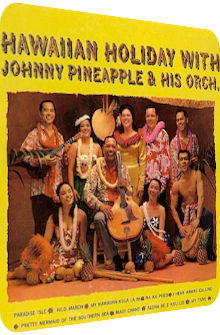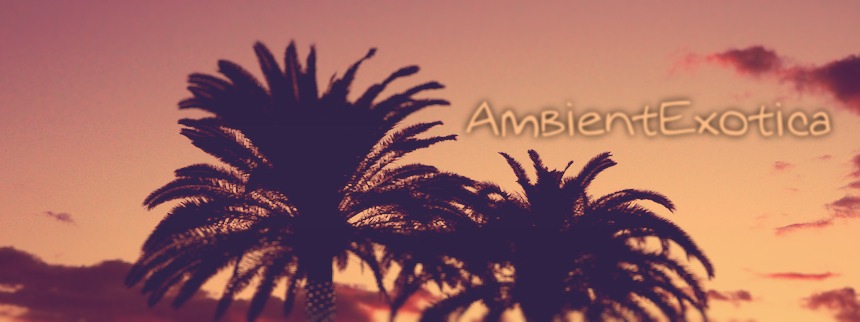
Johnny Pineapple
Hawaiian Holiday
1965
Hawaiian Holiday by entertainer and steel guitarist Johnny Pineapple, born David Haonohi, seems to be one of those records. One takes a look at the cover and knows what to expect, or alternatively, expects what one knows. And sure enough is this a Hawaiian album of the joyful and intimate kind, with sun beams glowing through every fissure, celebrating a new wonderful day in paradise. After one of his many memorable performances at the Edgewater Beach Hotel in Chicago, Haonohi got to sign his first record contract and gathered a group of largely unknown and unmentioned musicians around him; the liner notes are mostly silent in this regard.
Released in 1965 on the New York-based Pickwick Records and almost immediately licensed to several other labels, it encounters rougher market conditions, or in other words, the sunset phase of Exotica. Johnny Pineapple thus faces a problem and comes up with a solution: since records of traditional Hawaiian music – known as Hapa Haole and oftentimes considered to be either a subgenre of Exotica or an independent school – are already well-established in the middle of the 60's and start to slowly decline together with the Exotica craze, the Hawaiian maestro tries to fend off snobby notions by coming up with two unique compositions and by texturizing the whole material of nine songs in clever and unexpected ways, starting with grand piano accompaniments, going over to wafting flute tones and putting the finishing touches on the arrangements with either the help of a choir, vivid drums or noteworthy doses of tone sequences in minor which can be seen as an audacity in regard to the theme of an incandescent holiday.
The first look seems to meet the stereotypical thoughts, a second listening session, however, unravels curious counterintuitive decisions that expand the scope of the record, if only in masked and careful ways. Read more about this below, and why I consider this ephemeral LP to be a surprisingly attractive piece, even for Exotica listeners who aren't all too fond of ukuleles.
Johnny Pineapple decides to make Sam Koki's Paradise Isle the first stop of the vacation, stressing the links and ties to the album title by assuring the listeners that they aren't listening to a half-hearted Pacific Hapa Haole LP, but to an – admittedly Easy Listening-influenced and not overly deep – collection of Hawaiian tracks that do depict the feeling of visiting the Hawaii of the 60's in a truthful fashion. Acoustic guitars, warm double bass twangs and deliciously warped ukulele strings fuel the then already established cliché of hammock days in the sun. What elevates this composition to higher levels are the allotted xylophone droplets and the piano accentuations which work tremendously well in the given context, providing even counteracting traces of majesty in an otherwise daylight-illuminated ocean setting. One hell of a song for lazy beach strollers.
The next attraction is a short performance of Edgar Leslie's Hilo March, an uplifting ditty with an acoustic guitar framing and Pineapple's cheeky steel guitar infusions, otherwise best known as being featured on Arthur Lyman's Exotica debut Taboo (1958). It's a song to hum along with, but in the end a rather pale, non-essential and forgettable example.
While the following My Hawaiian Kula La Ni is an Aloa Oe-esque collaborative composition of Pineapple and his bandmates Tanassay and Terry which boosts the dreaminess with the help of a paradisiac alto flute, high-attack steel guitar twangs, solemn piano particles of different tone regions and even a too short inclusion of a harp, the penultimate offering of side A is a memorable fast-paced vocal take on Harry Owens' Na Ka Pueo in which Pineapple's chants mesh well with the euphony of his orchestra, the bongo eruptions and the convivial flute melody in sky-high regions. Double bass slaps and acoustic guitar accompaniments round off the blithesome signature track of this side, which actually finishes with an interpretation of Edward White's and Mack Wolfson's I Hear Hawaii Calling whose lure is realized with melodramatic vocal passages of Johnny Pineapple and Anita Kuulei, both of whom tower above wonderfully cascading piano tercets. Whispering scents of ukuleles and bass backings are interwoven, but the intimacy is nurtured by a vocal performance that would have made Alfred Apaka proud, who died one year before this release.
Side B features only four songs, but the positively kitschy vacation continues in an almost bedazzling technicolor scope. Starting with another jocular song written by Edgar Leslie, Pretty Mermaid Of The Southern Sea, it consists of a mélange of blurry ukulele riffs, a Sicilian tremolo performance on the steel guitar and coruscating piano sprinkles that change their characteristic traits in the second half, as they're hammered in a jaunty way, boosting the catchiness and fun this song provides. After a final repetition of the setting in higher tone regions, the second and final song consideration of Sam Koki is due: Maui Chant astonishes the listener with tribal beats and ethnic flutes, and the surprise factor only grows once the sizzling-hot ukulele and steel guitar entanglements are presented in tandem with Johnny Pineapple's lyrics, as they resemble the world-famous Goodnight, Ladies as composed by Edwin Pearce Christy in 1847 – aka "ancient times" – already, but the melody is structured differently enough to remain partially independent and unique. The drums really enhance the esprit, and Pineapple's frantic-friendly performance doesn't contain even a single molecule of schmaltz.
The following unique composition Aloha Oe E Kuu Lei by the trio of Pineapple, Terry and Tanassay has nothing to do with the best-known Hawaiian anthem, but is totally different; it may start in an equally dreamy fashion, but moves into shockingly bold tone sequences in minor, which are then silkened by a melancholic alto flute breeze and spiraling piano drops. Oscillating between nostalgia and balmy steel guitar-created reveries, this particular track is one of the strangest offerings that enhances the overarching theme with another facet. The outro song My Tane by Richard Gump, August Goupil and superstar Johnny Noble finishes Hawaiian Holiday with richly texturized soundscapes on a downbeat rhythm, encompassing mellow flutes, mellifluously downward spiraling piano chords and the known string instruments.
Hawaiian Holiday is a typical example of a Hapa Haole record if you view its overarching topos and well-established concept of a long-awaited holiday in Hawaii. Johnny Pineapple delivers nine tracks that all fit into this category and nurture the cliché and expectations of the listener. But as I've mentioned in the opening paragraph, it is so much more, and you wouldn't believe it if you don't pay close attention or are spoiled, even fed-up by the shedloads of lackluster cash-in opportunities that were thrown at the feet of the listeners during the 50's and 60's.
Hawaiian Holiday towers above the competition due to its pool of instruments – flutes, pianos, drums, the occasional xylophone – and the orchestral choir. While it doesn't reach the gargantuan scope of Alfred Newman's and Ken Darby's Ports Of Paradise, the choir does boost the respective mood of a song. Since it is really only used full-force on the rendition of Na Ka Pueo, its inclusion on the other material is strangely neglected, but this, as a result, allows both Johnny Pineapple and the largely instrumental soundscapes to shine even more. If you're avoiding Hawaiian music in general because of the warped twangs or the syrupy sun-soaked sugar straits, you might be offended by Pineapple's material as well, but rest assured that it remains one of the best records in this specific field and outshines many a vocal performance on an LP, even the mighty Alfred Apaka, at least to my ears; take his cool performance on I Hear Hawaii Calling into account, and you'll know what I mean. A surfer's attitude is implicitly hidden in every sung note. Fans of Hapa Haole records probably own this already, but even Exotica fans should risk a glimpse. Hawaiian Holiday isn't totally different from the competition, but its little tweaks and changes are luxurious enough to place it among the cream of the crop.
Exotica Review 125: Johnny Pineapple – Hawaiian Holiday (1965). Originally published on Sep. 22, 2012 at AmbientExotica.com.
